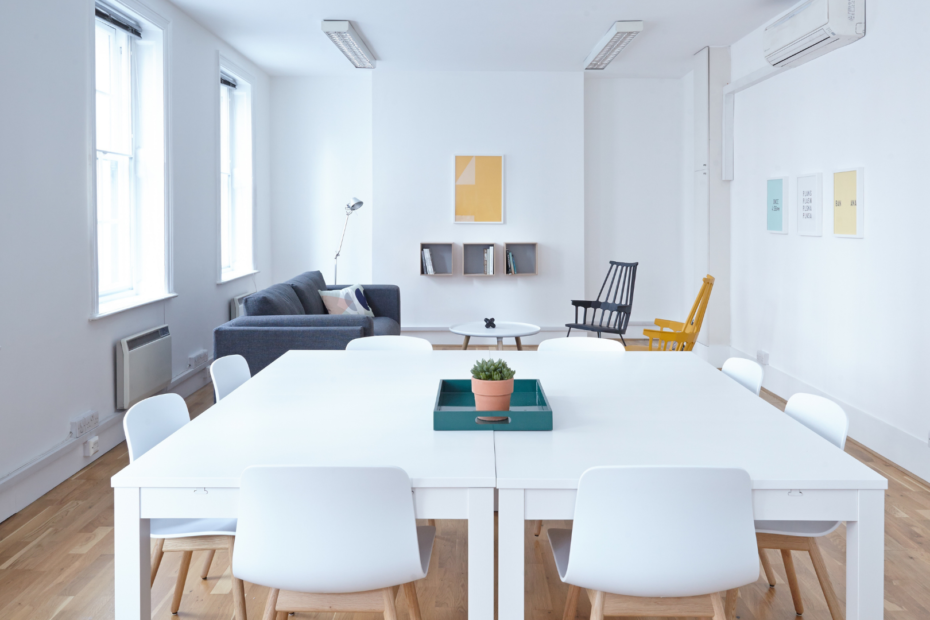“If a room is able to change our feelings, if happiness can depend on the colour of the walls or the shape of a door, what will happen to us in most of the places we are forced to look at and inhabit?” (De Bottom, 2006).
The workplace is one of the principal factors that characterise a person’s life experience as it accounts for the majority of the conscious time. It has been shown that over time the physical and social stimuli of the workplace can influence the performance, mental health and physical well-being of workers.
It is therefore important that companies takes into account key considerations when designing work spaces, with the aim of making them welcoming and stimulating for their workers.
- Rule: Consider the role that colours play
The colour themes in an office can influence the productivity and mood of employees. Colour has a strong impact on mental and emotional harmony – a concept that is supported by the principles of colour therapy. Using colours consciously it is possible to create a welcoming and relaxing working environment that stimulates creativity.
For example, when choosing which colours to use, it is interesting to note that warm colours (e.g. yellow and orange) have been known to increase blood pressure, boosting our energy and vitality and stimulating positive and welcoming feelings such as cheerfulness and happiness as well as encouraging creativity and productivity.
Cooler colours such as blue or green on the other hand can impact breathing and focus as well as conveying a feeling of calm and tranquillity. In particular, Green conveys balance, harmony and calm while simultaneously stimulating efficiency. Turquoise is the colour of creativity and communication and has been known to help calm workers put people at ease while blue symbolises confidence, constancy and intellect.
Knowing that colours can affect people’s psyche, selection of a colour theme should not be made at random. First one should determine the type of vibe that suits the business and its workers. This in turn will then help in the selection of the colours that can be used in order to create that vibe.
2. Rule: Focus on environmental design.
Nature is making a comeback in office design. Recycled materials, reclaimed wood panel installations and resin floors are popular. High ceilings and large windows create good ventilation and allow in natural light and are increasingly common in office environments.
In particular, natural lighting and ventilation have been shown to improve employees state of mind as well as well being, thereby increasing performance and creativity. Use of natural lighting also reduces the need for artificial lighting and hence reduces the carbon footprint of the company, creating an opportunity for cost savings..
Use of plants in offices has long been recognised to play a central role in office layout because it is believed that green interior design can boost an employee’s mood and bring enormous health and well being benefits.
3. Rule: Create a relaxation room.
A break-out room is a place where employees can relax and take their mind off work for a few minutes. The goal of a break-out room is to improve the physical and mental well being of workers and encourage interaction with colleagues helping build closer ties and better relations. This in turn leads to better teamwork and performance.
In addition to the above benefits, taking short breaks in between several hours of work helps to rest the mind and help with fresh ideas. Workers can recharge their batteries and return to work with greater concentration. With this in mind, it is important that the relaxation room is designed with key features such as a coffee corner, comfortable seating and reading material to distract the mind. Colours such as green and blue can bring relaxation and create calm. A snack area has been known to be effective with healthy products as well as equipment for storing foods so that employees can choose to prepare their own lunch and thereby spend more time with team members.
4. Rule: Allow new working spaces.
Another important factor to consider when creating stimulating work spaces is to avoid lifeless and grey cubicals and closed individual offices. Increasingly companies are using multi-purpose spaces that can be used for work as well as dbreak outs – eg multimedia presentations and town halls held in areas that can also be used for team get togethers. The old fashioned concepts of individual cubicals and isolated desks are gradually being abandoned in favour of open plan office and oval office desks, which allow 4-6 people to work together, motivate each other, collaborate and, paradoxically, ensure greater concentration. These developments are being driven because companies are looking for more interaction, sharing and collaboration between their employees.
In conclusion, design is one of the key factors that determine the effectiveness of a workplace, helping to influence the well-being of the employee spending . This is why it must not be neglected if you want to achieve greater productivity from your team, but reinvented.
What colour would you like the walls of your office to be?
Written by Sofia Radio, Psychometrics srl
